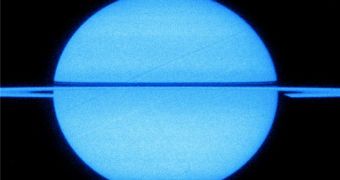Saturn is undoubtedly one of the most interesting cosmic bodies in the solar system, this being one of the main reasons why NASA and ESA decided to send the Cassini-Huygens mission to investigate it. Over the past six years, we gained a wealth of new data on the planet, but some mysteries still endured. One good example is the gas giant's radio emission pattern, which baffled astrophysicists since day one. Another is the aurora astronomers found at Saturn's north pole, which apparently pulsates once each Saturnine day, AlphaGalileo reports.
In the case of the giant planet, the aurora looks like an ethereal ultraviolet glow spreading at its north pole. Analyzing this feature was however made very difficult by the fact that the radio waves Saturn emits do not actually help keep track of the planet's days. This is another mystery astronomers have been unable to crack for many years, namely the length of a day on the gas giant. At first, they thought that a single batch of radio waves was emitted per day, and so that info was used as a reference point. But recent studies have shown that these emissions cannot actually be used to determine the length of a Saturnine day.
This bizarre aspect has incited a lot of the debate in the astronomical community, where experts proposed a variety of reasons for the wide variations recorded in the radio wave emission patterns. In a new report, which will appear in the August 6 issue of the esteemed scientific journal Geophysical Research Letters, experts from an international team announce that the emission patterns are actually in tune with the auroral pulsations. The research effort was spearheaded by experts at the University of Leicester, who were led by scientist Dr Jonathan Nichols. The specialists used Hubble data collected between 2005 and 2009 to reach this conclusion.
“This is an important discovery for two reasons. First, it provides a long-suspected but hitherto missing link between the radio and auroral emissions, and second, it adds a critical tool in diagnosing the cause of Saturn’s irregular heartbeat,” Nichols says. “This confirms that the auroras and the radio emissions are indeed physically associated, as suspected. This link is important, since it implies that the pulsing of the radio emissions is being impacted by the processes driving Saturn’s aurora, which in turn can be studied by the NASA/ESA spacecraft Cassini, presently in orbit around Saturn. It thus takes us a significant step toward solving the mystery of the variable radio period,” he concludes.

 14 DAY TRIAL //
14 DAY TRIAL //